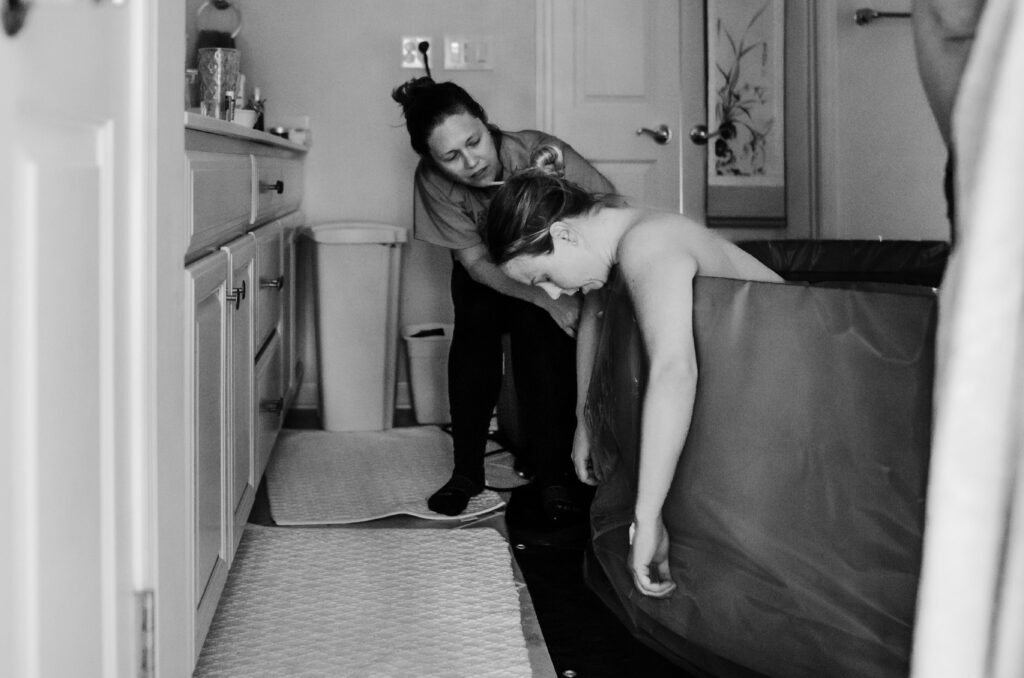“…Convert, O God! my pain into delight at the lovely sight of a living, well-formed and healthful babe…” –Fanny Neuda, Untitled Personal Prayer, Published 1878
When Debra Orenstein first called me to contribute an essay on “Childbirth in Judaism,” she did not find me at home: I was, as it happens, in the throes of childbirth. It was a mixed omen: Though I had the recent experience of childbirth, Judaism was not officially present at the occasion. I was struck by the irony of Judaism’s absence from one of the only occasions that I would dignify with the language of religious experience: “awesome,” “transformative,” “at once terrible and wonderful,” and “miraculous.” The expression “religious experience” does not do much for me, but more than anything else in my life the births of my daughters, Ronya, six years ago, and Samara, a year ago, invite this designation. I have privately treated these occasions in what might be considered religious ways: I return in my imagination to the births of my children regularly, as one returns to a mantra, recalling the initial pangs, the feelings of anxiety and anticipation, the long car rides to the hospital on country roads, the specific ways my spouse supported me, details and more details to the emergence of the baby herself, and then the phone calls, the order in which I made them, the words said.
Through tireless mental review, I retain the memory – to pass these stories on to my children as my birth story was passed on to me. Also, these commemorations calm and uplift me. They are a private version of public rituals of remembrance like the Passover seder or Yizkor that offer both comfort and inspiration. Although pregnancy and labor happen routinely and require less deliberate effort than some other tasks (such as writing assignments), giving birth felt like a personal triumph (“I did this!?!”), as unique as the babies themselves. Yet for all this religious language, there was nothing markedly Jewish in my response, not so much as a Sheheheyanu (blessing for reaching a new or momentous occasion) to acknowledge the newness of it all.
I take my Judaism seriously enough to honor ritual observances and time-honored practices, such as those prescribed by the dietary laws; seriously enough to be interested in liturgical innovation, contemporary invention of midrash, and other strategies of engagement with the tradition which enable women to reclaim a classically patriarchal heritage. Judaism’s unselfconscious absence at the birth of my daughters was, therefore, remarkable.
Judaism made its appearance in Ronya’s life first with her Simhat Bat, a welcoming ceremony that my spouse and I composed for her with much care. When Samara was born, we invoked Judaism earlier in the newborn’s life, with Rabbi Sandy Eisenberg Sassos’s prayers for homecoming; Ronya recited the sibling prayer, and my spouse and I said prayers for our expanded family.1 But, we recited no Hebrew to acknowledge conception, or at the onset of labor, or in the delivery room. For the event of childbirth itself we knew no legal, ritual, or liturgical mandate, and we did not think to discover or invent one. With the assignment of this essay I wondered how it is that someone with my Jewish commitments, married to a rabbi, and dedicated to feminist innovation in Judaism could have neglected to sanctify Jewishly my most sacred events.
My own neglect is consistent with a historical neglect of childbirth both in institutionalized Judaism and in Jewish writing. This negligence is not due to an absence of customs and sources, but rather to their underutilization and, in some cases, to their having been forgotten. One explanation for the neglect can be found in the overall treatment of women and women’s bodies in Judaism and another in the nature and history of childbirth itself.
Childbirth: Noticeably Absent, Conspicuously Central
Historically, responses to childbirth are characterized by ambivalence–terror of death beside holy awe in the hope for new life. Women’s prayers, such as the tkhine (petitionary prayer for and/or by women, traditionally written in Yiddish), from which my epigraph was taken, capture this ambivalence. Neuda begins her prayer in awe and then begs pardon and confesses her dread and anxiety. She pleads for courage and makes the poignant request that the life of her child not be her own death. “Mercy” is the poet’s ultimate plea.2 In general, tkhines characterize childbirth as curse and blessing, and they represent women as both vulnerable and strong, their voices close to God’s ear.
Childbirth is the subject of contradictions: That which is most distinctively female and most in the image of the divine (the power to create life) is represented as God’s curse to Eve and to the generations of women. The curse functions in marked tension with childbirth represented as blessing: The command to be fruitful and multiply (the first biblical commandment) and the fervent prayers of the matriarchs and the other “barren” mothers of biblical heroes. At the same time, Levitical purity laws identify the postpartum mother as impure (Leviticus 12:1-8), and most sources from the Rabbinic through the medieval periods focus on purity questions, with special anxiety about how to respond to the death of the mother. (We learn that she must be buried in her bloody clothes.)
When I raised the question of childbirth’s low profile in Judaism with my father-in-law, whose training was from a classical Lithuanian yeshiva, he suggested that once the powerful system of purity laws kicked in, it would have interfered with imagining the childbearing woman as anything other than a vessel of impurity. I argued: Judaism has codified rules, rituals and blessings for everything; we have a blessing to recite if we see a rainbow. Surely something should be muttered in awe, thanksgiving, or petition if you are present to see a human head emerging from a vaginal opening. He reminded me that the Rabbinic position against looking at “that place” would have precluded any blessing.
This attitude towards female sexuality and the categories of classical Judaism may have obscured the female religious expressions that are available to us in our textual tradition. When we avoid dependence on patriarchal models of liturgy and ritual and that which has the force of law, we can begin to hear women’s voices: Sarah’s laughter when informed of her pregnancy, Hannah’s apparently drunken muttering as she prayed for a child, the screams of our grandmothers as they pushed our parents into the world. We can find powerful Jewish images and symbols in such things as breast milk, menstrual blood, and amniotic fluids. We can thus discover alternative categories and images both for reviewing the traditional place of childbirth in Judaism and for investing childbirth with sanctity in the present.
The process of developing Jewish responses to childbirth facilitates the perception of its already pervasive presence. For example, laws govern procreation, intercourse, and postpartum behavior; stories in Bible and midrash connect childbearing, women, and God; the liturgy around childbirth includes berakhot (blessings)-ancient and modern–a rich tradition of tkhines and psalms recited before and after birth. In addition, there are folk traditions and rituals–again, both ancient and modern. The work of recovering, reinventing, and instituting appropriate Jewish responses to childbirth has begun in earnest, significantly in middle-class America in the 1990’s, as fathers now regularly enter the delivery room and as childbirth has become safer than ever before.
“Adding childbirth to Judaism” means adding it for Jewish men, as well as Jewish women. For example, once childbirth is reclaimed as a Jewish event and theme, Rosh Hashanah (New Year), the birthday of the world, can serve as an invitation to reimagine God as a laboring mother. The metaphor can be sustained: God’s creative strategy–a classification system that makes meaning by separating this from that–is also like human birth, a process of separations. Developing the analogy of divine creation to birth, Orenstein has observed that individuated life begins with a physical tearing away of one body from another and that psychological health requires further successful acts of separation. She has also noted that a feminized version of the morning prayer Baruckh She’amar (“Blessed is the One who spoke and the world came into being”) yields a line which can be translated “Blessed are You who has mercy on the earth” or “Blessed are You who wombs (i.e. whose water breaks) over the earth.”
The tradition has resisted establishing an affinity between God’s work and maternity, as God’s labors have been masculinized. Sanitized by myth, the birth of the first human creature is a startlingly bloodless and painless event: God takes Adam from the earth (Genesis 2:7). Closer to subsequent human experience, and, at the same time, a reversal of it, woman is brought forth from man’s body (Genesis 2:21-22). The birthing of life–in human experience an activity in the provenance of the female — is represented as the work of a male divinity and then seems to be given over to the man until another story intervenes to give childbirth to the future generations of women. Perhaps jealous of woman’s procreative powers, patriarchal religion posits a creative male God and gives childbirth to women not as a gift, but as a curse.
Maternity and Blessing: Following Sarah, Our Mother
However powerful the curse in Eden (the focus on pain possibly standing as silent acknowledgement of the potential for death in childbirth), Genesis also represents maternity as the most important fact of woman’s existence, the blessing for which she prays. Perhaps overcompensating for the fear of death in childbirth, biblical heroines often feel their lives are meaningless without children. Curse that childbirth may be, barrenness is worse, and pregnancy is devoutly wished for by all the “barren mothers” of Scriptures. The convention of the “barren mother” reasserts divine prerogatives over creation because when heroes, such as Isaac, Samson, and Samuel, are born to barren mothers, God necessarily and miraculously enters history.
The instance of Sarah, the first matriarch, may be the most dramatic. Sarah is old when she overhears that she will have a child, and she laughs enigmatically. In delight? (“Finally!”); terror? (“Can I do this?”); bitterness? (“So late in life”); cynicism? (“You are kidding”). Sarah’s laughter may be the laughter of wonder, anger, nervousness, or some combination of the many emotions that laughter can express. God asks why Sarah laughed, and when Sarah fearfully denies having laughed, God–who evidently sees what we do, but like Freud after him, is at a loss for an interpretation when it comes to women’s motivations–says, without apparent reproach, “But you did laugh.”
Sarah’s response rings with the laughter of women across times and places who may well have reacted to the news of a baby in their future with mirth, scorn, or as they say, “God knows what.” I too laughed when I became aware of my pregnancies, and I walked around laughing inside for a long time. Whether one’s pregnancy came easily or with difficulty, whether planned or not, it is surely among the moments in life (to those who are inclined to think in these terms) when one feels the other world impinging on this one, either miraculously or demonically. So Sarah laughs. She utters no blessing. She performs no ritual. We know that circumcision was the sign of God’s covenant, and we even learn about the weaning celebration that Abraham held for Isaac, but the details of this first birth to the first matriarch and patriarch are omitted: When did Sarah go into labor? Did she scream? Did Abraham feed her ice chips? More realistically: How close did the aged mother come to death? Did she greet her baby with pleasure or depression? Did her milk come in easily? The text does not imagine any parental response at all: No prayer, no ritual of thanksgiving, nothing upon which future generations of parents can base a liturgical, ritual, or other Jewish response to childbirth.
Yet I imagine the possibility of using Sarah’s laughter as part of new pregnancy rites. Sarah’s laughter is central to our self-definition as a people. Sarah and Abraham name the child born of God’s extraordinary promise Yitzhak (“he will laugh”), not only in memory of laughter but with the promise of laughter to come. As such, we are all heirs to Sarah’s laugh. This story allows me to imagine prayers with Sarah’s laugh as a governing metaphor, and rituals that incorporate stylized and choreographed laughter. In response to this “imagining,” Orenstein has written a brief prayer:
| As parents, we pray for our child’s complete fulfillment May s/he have all the blessings we have had and more; may s/he be blessed with gifts we have not yet imagined. As God laughed when the rabbis surpassed even divine expectation, may we, too, laugh delightedly and say, “My children have surpassed me. My children have surpassed me.” |
| —after BT Baba Metzia 59b |
Fruits–and Religious Acknowledgements–of the Womb: A Review of the Sources on Childbirth
Until very recently, few birth ceremonies were practiced. Susan Weidman Schneider, in her now classic book Jewish and Female, writes with reference to giving birth that “there has been scant traditional ritual around the women in the picture–whether as mothers or daughters.” She echoes Blu Greenberg’s question: “Could it be that if men had been giving birth all these centuries, some fantastic ritual would have developed by now?”3 Instead, Arlene Rossenn Cardozzo’s Jewish Family Celebrations and Jacob Neusner’s The Enchantments of Judaism are exemplary in that they identify themselves as comprehensive of the stages of Jewish life and begin describing life rituals not with fertility, conception, pregnancy, labor, or even birth itself.4 These books and others like them begin with Brit Milah (covenant of circumcision ritual) and sometimes with the conferral of a name for a daughter. Given high rates of infant mortality, Judaism may have cautiously waited to celebrate birth at the Brit when one could be more confident in the baby’s viability.
Psalms and Blessings The mandate of tradition around birth has been limited. Psalm 126 has long been associated with birth, likely due to the verse “Those who sow in tears will reap in joy””(Psalms 126:5). Psalm 118, which begins “Out of the narrow place I called upon God, who answered me in spaciousness” has been paraphrased in Yiddish and recast as a tkhine for childbirth. It tells of coming close to death, but not succumbing, and of trusting in God.5 Brief blessings of thanksgiving at birth itself are increasingly usual in Orthodoxy: the birth of a son commands the blessing Hatov Vehmetiv (naming God as good and the doer of the good), and a daughter is greeted with the Sheheheyanu prayer, expressing gratitude for sustaining the lives of the parents to this moment. Postpartum, a mother, or her spouse on her behalf, bentshes gomel (recites the prayer of thanksgiving for coming through danger in safety) in the synagogue.
Traditions and Conception While the legal mandate is small, folk traditions have been sustained through the ages. Monthly ritual immersion can be understood as signifying readiness for motherhood. In addition, Jewish mystical tradition encourages lovemaking on Friday night, and considers a conception on the Sabbath particularly blessed, since Shabbat is said to reunite the male and female aspects of God. From the fervent prayers of the barren mothers of Scriptures, until our own century, Jewish women have maintained traditions of petition to God for conception. Women hopeful of fertility have long invoked the names of Rachel and Hannah, the classic “barren mothers,” and have wept beside Rachel’s tomb in Israel.
Women’s Prayers before the Enlightenment Recent years have seen the publication of women’s prayers that focus on childbirth in its many stages: Prayers for conception, for each of the months, for the beginning of labor, for the stages of childbirth, and for the postpartum. Books such as Nina Beth Cardin’s translation Out of the Depths I Call to You and Tracy Guren Klir’s collection The Merit of Our Mothers have again brought to light poetry and prayers which women shared for several centuries, but which fell into virtual darkness during the Enlightenment.6 These prayers have provided source material for recent efforts of Jewish women to sanctify childbirth in ways authentic to both Judaism and women’s history.
Chava Weissler, an expert on tkhines, observes that the male Rabbinic tradition “collapses all women into Eve” and makes much of the association between sin and childbirth. The tkhines that seem to be authored by women, in contrast, plead for the health and safety of mother and infant and address the question of suffering. As Weissler writes, attention is paid to “the physical discomfort, pain and danger women experience in menstruation and childbirth. The authors of the tkhines want to know why women suffer, not why they bleed.”7
Contemporary Liturgy and Ritual Tkhine literature nourishes contemporary efforts to produce liturgy and rituals for childbirth. In The New Jewish Baby Book, Anita Diament reprints Judy Shanks’ beautiful tkhine written in a modern idiom. Shanks prays for the health of her child, the health of the world, and the ability to love and nurture.8 Jane Litman’s “M’ugelet: A Pregnancy Ritual” uses a cord that had been wrapped around Rachel’s tomb. A group of women recite adapted tkhines and pass the pregnant woman around a circle, chanting personal blessings as she becomes entwined by the cord to which she may later cling while giving birth. This ceremony resonates with some older customs recorded by Douglas Weber and Jessica Brodsky Weber in the Jewish Baby Handbook; they write that a woman in difficult labor was sometimes given the keys of the synagogue to clutch or the cord that binds the Torah.9 Along with Litman’s ritual, Elizabeth Resnick Levine’s A Ceremonies Sampler includes a Yemenite postpartum celebration, welcoming ceremonies for new babies, a weaning ceremony, and Sasso’s personal prayers mentioned earlier.10 Women have also borrowed images from the Jewish wedding in creating childbirth rituals. In the Reconstructionist, Shoshana Zonderman describes a ritual that she designed for twelve women on the last full moon of her pregnancy; it included a ceremony parallel to the wedding and a document parallel to the ketubah (wedding contract). The women used symbols and fruits, breathing exercises and chanting, and they completed a Jewish mandala upon which the mother focused during labor and which now has a permanent place in the family home.11 Dr. Tikva Frymer-Kensky, z”l, has drawn on a variety of ancient traditions – Jewish and non-Jewish – in creating liturgical poems for pregnancy and childbirth.12 Schneider in Jewish and Female includes Nechama Liss-Levenson’s and her husband’s simple ritual for conception: The couple marked their decision to stop using contraception by making Kiddush (blessing over wine on Sabbath or holidays) and reciting the Sheva Berakhot (seven marital blessings) to reestablish the traditional connection between marriage and childbirth, and to sanctify their choice to wait until they were ready to conceive.
Several women who have created new prayer and ritual shift focus from the birth of the baby to the birth of a “mother.” Zonderman writes that she
| thought of her advancing pregnancy as a passage through a constricting tunnel to emergence with a revitalized, fuller identity as a Jewish mother – a birth image. This is also the metaphor of the Exodus from Egypt – mitzrayim (Egypt) being a narrow (tzar) place of oppression – when the Israelites passed through the (birthing) waters of the Red Sea to accept new ethico-religious obligations at Mt. Sinai. In becoming a mother, I was accepting new responsibilities and a commitment to the future of the Jewish people.13 |
The Trends in New Rituals
These new religious expressions of gratitude are particularly effective in their appropriation of feminine biblical metaphors. The exodus from Egypt through the parted Red Sea is the central moment in the drama of the Israelite past, and it remains the central metaphor for Jewish redemption. Only recently have we stressed that it is a birth metaphor, the passage of people into a new life of trials and triumphs through parted waters, after which nourishment in the form of manna is bestowed like mother’s milk, various in its taste, and supply generated by demand. The practice of ritual immersion might be reimagined in analogous ways by invoking, for example, Miriam’s well, the source of water for the Israelites in the desert. Amniotic waters can be seen as analogous to the tohu vavohu (hurly burly) out of which God labored in birthing the world. The bringing of first fruits to the Temple also finds a new vitality as a feminine image of birth per se when it is brought back to the experience of childbirth in new rituals and prayers.
New as these compositions are, they can be especially poignant when they speak with the force of tradition. For example, in many Jewish families, including my own, it is customary to add a candle to one’s Sabbath candelabrum for each new family member. A yartzeit (anniversary of a death) candle is burned when a Jew dies and annually on the anniversary of a family member’s death. A ner neshama (soul candle) is often lit at brit and naming ceremonies. Recognizing the candle as a Jewish symbol for the soul, a group of contemporary women liturgists have suggested a rite of conception in which an unlit candle is introduced to the Sabbath candelabrum.14 In the unfortunate event of a failed pregnancy, this candle would be ritually burned, like a yartzeit candle, as an act of mourning. An abortion is marked by submerging the lit candle in water. Under happier circumstances, on the first Sabbath following the birth of the baby, the unlit candle becomes a light among its companions and its place is permanently filled on the candelabrum. The pregnancy rite speaks in a Jewish idiom that extends itself and assimilates naturally into Jewish practice.
Reclaiming “The Body” of Tradition
Contemplating how childbirth can connect us to our foremothers has reminded me of one of the few details that I know about my paternal grandmother, who gave birth to eight children. My father, who was the second oldest, recalls that the older children were made to leave the house when his mother delivered. Still, she screamed loudly enough that the frightened boy could hear. I screamed my heart out when Samara was born and hoped at that moment that my grandmother’s screaming may have been like my own: Liberated, defiant of pain, awe-struck, thrilled. I have come to think of my screams as my foremothers’ and my Judaism’s presence in the delivery room. The work of naturalizing and assimilating women’s responses to childbirth is in progress. And there is much work still to do–to honor the laughter of Sarah, to sanctify the screams of our mothers, and to bequeath powers of articulation to our daughters as they labor in the creation of worlds to come.
————————-
Excerpt from LIFECYCLES VOL. 1: JEWISH WOMEN ON LIFE PASSAGES, PERSONAL MILESTONES, Debra Orenstein (Woodstock, VT: Jewish Lights Publishing, 1994). Permission granted by Jewish Lights Publishing.













